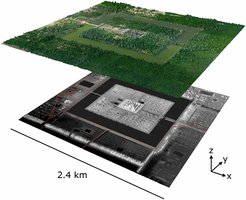Points in Time and Space: New Method for Estimating Age of Lidar-detected Structures
In a new study titled published in Scientific Reports, a team of researchers led by the Max Plank Institute of Geoanthropology applied statistics and machine learning to develop a predictive model for the foundation of new structures.
Recent advances in archaeological research such as lidar and remote sensing have led to a wealth of data about where ancient structures were built. They have even recently enabled researchers to predict that there may be more than 10,000 ancient structures still hidden in the Amazon. But adding temporal context to this spatial data, thereby determining how urban areas developed throughout time, remains a significant challenge.
In a new study titled published in Scientific Reports, a team of researchers led by the Max Plank Institute of Geoanthropology applied statistics and machine learning to develop a predictive model for the foundation of new structures. In the hope of better understanding historical patterns of ancient tropical urbanism, the researchers used the well-documented Angkor site in Cambodia as a case study. The new model was able to produce a historical population curve for Angkor, demonstrating how machine learning and Bayesian statistics can add chronological information to large lidar datasets.
Estimating Temple Foundation Dates

Angkor, with its impressive temples and complex infrastructure, has been a focal point for researchers aiming to understand the development of ancient urbanism. By estimating the historical growth patterns of the city, the study sheds light on the architectural choices, societal transformations, and environmental factors that shaped Angkor.
To achieve these results, the study involved enhancing an existing predictive model for estimating temple foundation dates at Angkor. The researchers used remotely-sensed data to identify undated temples, developed a predictive model that combines traditional regression methods with advanced machine learning techniques, and updated the database of Angkorian temples. When comparing models, based on historical and spatial data, the researchers concluded that the Bayesian approach could more effectively incorporate uncertainties and potentially offer more accurate chronological predictions.
New Methods, More Understanding
The findings of this study mark a noteworthy advancement in archaeological methodology and palaeo data science. By helping to provide a better understanding of ancient urban landscapes and societal changes, these methods reveal the adaptive abilities and diverse lifestyles of our human ancestors and enrich global heritage appreciation.
This research opens up exciting possibilities in the field of archaeology. Lidar technology and Bayesian regression offer the potential to explore numerous ancient cities worldwide. The study suggests several avenues for future research, including empirical model testing, evaluation of alternative modeling approaches, and the application of chronological predictive methods to other tropical regions with available archaeological lidar data.
